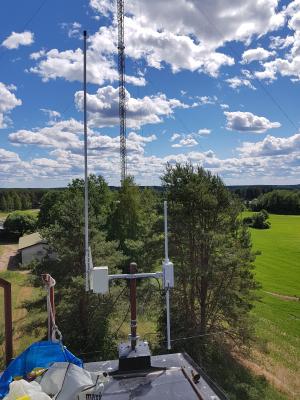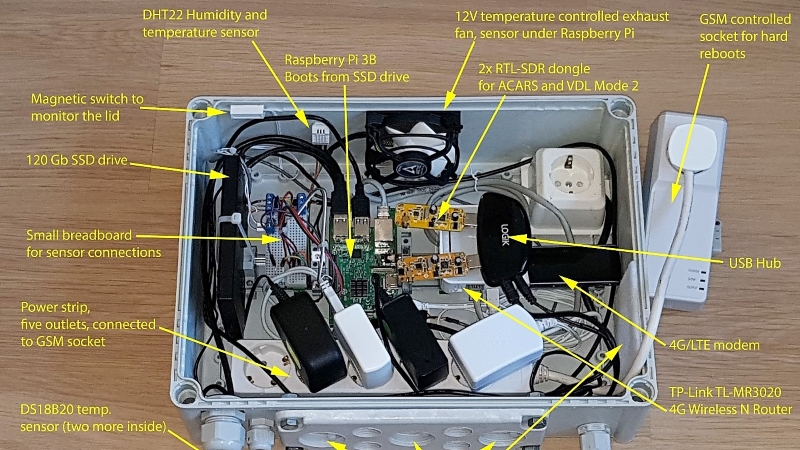When installing almost any kind of radio gear, the three factors that matter most are the same as in real estate: location, location, location. An unobstructed location at the highest possible elevation gives the antenna the furthest radio horizon as well as the biggest bang for the installation buck. But remote installations create problems, too, particularly with maintenance, which can be a chore.
 So when [tsimota] got a chance to relocate one of his Automatic Dependent Surveillance-Broadcast (ADS-B) receivers to a remote site, he made sure the remote gear was as bulletproof as possible. In a detailed write up with a ton of pictures, [tsimota] shows the impressive amount of effort he put into the build.
So when [tsimota] got a chance to relocate one of his Automatic Dependent Surveillance-Broadcast (ADS-B) receivers to a remote site, he made sure the remote gear was as bulletproof as possible. In a detailed write up with a ton of pictures, [tsimota] shows the impressive amount of effort he put into the build.
The system has a Raspberry Pi 3 with solid-state drive running the ADS-B software, a powered USB hub for three separate RTL-SDR dongles for various aircraft monitoring channels, a remote FlightAware dongle to monitor ADS-B, and both internal and external temperature sensors. Everything is snuggled into a weatherproof case that has filtered ventilation fans to keep things cool, and even sports a magnetic reed tamper switch to let him know if the box is opened. An LTE modem pipes the data back to the Inter, a GSM-controlled outlet allows remote reboots, and a UPS keeps the whole thing running if the power blips atop the 15-m building the system now lives on.
Nobody appreciates a quality remote installation as much as we do, and this is a great example of doing it right. Our only quibble would be the use of a breadboard for the sensors, but in a low-vibration location, it should work fine. If you’ve got the itch to build an ADS-B ground station but don’t want to jump in with both feet quite yet, this beginner’s guide from a few years back is a great place to start.
















Why so many people use a Raspberry Pi. for outdoor applications I’ll never know as it does not have a industrial temp range. So expect it to fail when it gets to hot or cold.
It’s not characterized for industrial, but that doesn’t mean that it won’t work.
At idle, it burns enough power to keep it warm at reasonable low temps, and there are larger problems if the outdoor temp is above 85C.
Correction: 70C for commercial, but that’s still mighty toasty.
There’s a link to the pictures on imgur from the Reddit post and the box of pi stuff seems to be mounted indoors so this is probably a moot point.
a cow’s opinion.
a moo point.
dang it, ignore the report plz.
I left a Pi 0 in a sealed tupperware under the bushes last Maine winter, fared the -17c lowest low we had with absolutely no issues.
It just works. I have piAware, only one receiver, mine is in the waterproof box, so it doesn’t have any cooling and it works for two years without any problems.
Thank you for letting people know about my little project! One reason for posting was to inspire people to try out this exciting (but not necessary expensive) hobby.
Cheers,
Tomi from Finland
Hi i know this was a long time ago but maybe solar power the receiver and get it atop of that Ham tower and relay the messages back using LoRa or similar….Imagine the coverage then
I have been thinking about doing the same thing (less access to mains power). The solar and power management have been something that keeps moving this project down the list.
This is a nice project about solar powered Pi’s and Arduinos:
https://www.switchdoc.com/project-curacao-project-page/
It’s a weather station, but it can run anything, of course! :-)
I think this could be simplified a bit – consolidate the low voltage power supplies into a single unit controlled via a relay on the low voltage side with a 555 watchdog connected to the Pi. Route LV power from indoors (if the box is outdoors, I’m not completely clear on that?) – a little bit safer. Replace the router malarkey with a 4G USB stick directly connected to the Pi. Fewer moving parts, hopefully more reliable (I’d be concerned about the need to remotely reboot tbh – it’s not a taxing task from a software perspective).
Thanks for you thoughts! The Pi is already powering SSD drive and FlightAware dongle, so I did not want to overload it with LTE modem. Now, an external 4G modem/router allows me add more Pi’s or maybe a IP camera (all-sky camera perhaps?) into the system.
Everything is located indoors, except FlightAware dongle nexto the antenna and Bias-T powered LNA and filter next to VHF antenna. Next version will have DIN-rail attached modular power supplies, metal enclosure etc. Actually I have a DIN-rail in current setup (SSD, Pi, sensors, etc are attached to it). It just got buried under all the equipment! :-)
Did you have any trouble with the LTE modem de-sensing the receivers? It transmits at quite high power…
I guess it’s not a big issue in practice as the LTE modem only transmits after an ADSB message is received.
No problems at all. The LTE modem inside enclosure did not work in coutryside, so I was forced to use an external modem/router which is a bit further away. All three RTL-SDR’s receiving voice and data at least 200kms away! FlightAware dongle at the end of USB-extension (outside, next to antenna) receives positions 450+ km.
been there, done that, had great fun. I had different setup tho, i have used ethernet so i had POE, i utilizated heater inside and LNA. Great work!
What powered USB hub are you using for the 3 RTL-SDR dongles? I have 3 dongles on my Pi 3 and once in a while I lose connection with one of the dongles. Want to make sure I get the right hub with enough power.
It is this model:
https://www.amazon.co.uk/Hama-USB-2-0-Hub-Hi-Speed/dp/B000JIC1UK
After two and half months there has been zero hardware related issues with the RTL-sticks!
-Tomi